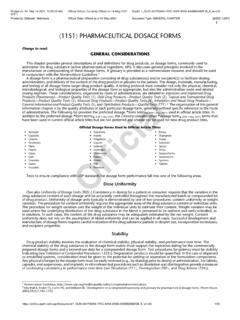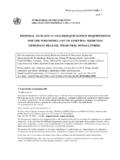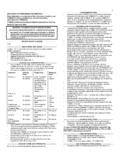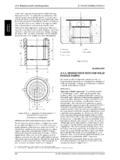Transcription of Pharmaceutical Dosage Forms - Temple University
1 Pharmaceutical Dosage FormsCapsulesEdited byLarry L. AugsburgerStephen W. 36/15/2017 3:04:58 PMCRC PressTaylor & Francis Group6000 Broken Sound Parkway NW, Suite 300 Boca Raton, FL 33487-2742 2017 by Taylor & Francis Group, LLC CRC Press is an imprint of Taylor & Francis Group, an Informa businessNo claim to original Government worksPrinted on acid-free paperInternational Standard Book Number-13: 978-1-84184-976-8 (Hardback)This book contains information obtained from authentic and highly regarded sources. Reasonable efforts have been made to publish reliable data and information, but the author and publisher cannot assume responsibility for the validity of all materi-als or the consequences of their use. The authors and publishers have attempted to trace the copyright holders of all material reproduced in this publication and apologize to copyright holders if permission to publish in this form has not been obtained.
2 If any copyright material has not been acknowledged please write and let us know so we may rectify in any future as permitted under Copyright Law, no part of this book may be reprinted, reproduced, transmitted, or utilized in any form by any electronic, mechanical, or other means, now known or hereafter invented, including photocopying, micro-filming, and recording, or in any information storage or retrieval system, without written permission from the permission to photocopy or use material electronically from this work, please access (http://www . ) or contact the Copyright Clearance Center, Inc. (CCC), 222 Rosewood Drive, Danvers, MA 01923, 978-750-8400. CCC is a not-for-profit organization that provides licenses and registration for a variety of users. For organizations that have been granted a photocopy license by the CCC, a separate system of payment has been Notice: Product or corporate names may be trademarks or registered trademarks, and are used only for identifi-cation and explanation without intent to the Taylor & Francis Web site the CRC Press Web site 46/15/2017 3:04:58.
3 XiContributors ..xiiiChapter 1 Advances in Capsule Formulation Development and Technology ..1 Larry L. Augsburger and Stephen W. HoagChapter 2 An Introduction to Two-Piece Hard Capsules and Their Marketing Benefits ..15 Dennis MurachanianChapter 3 Hard Shell Capsules in Clinical Trials ..31 Moji Christianah Adeyeye and Amusa AdebayoChapter 4 Capsule Shell Manufacture ..75 Brian E. Jones, Fridrun Podczeck, and Paul LukasChapter 5 Non Gelatin-Based Capsules ..111 Sven StegemannChapter 6 Hard Shell Capsule Filling Machines ..131 Donald K. LightfootChapter 7 Instrumented Automatic Capsule Filling Machines and Filling Machine Simulation ..191 Larry L. Augsburger and Vikas MoolchandaniChapter 8 Dry-Fill Formulation and Filling Technology ..211 Pavan Heda, Vikas Agarwal, and Shailesh K. SinghChapter 9 Plug Formation ..237 Fridrun PodczeckChapter 10 Modeling Powder Filling during Encapsulation.
4 283 Ammar Khawam, PhDChapter 11 Scale-Up and Transfer of Hard Shell Formulations across Machine Types ..307 Larry L. Augsburger and Michael 76/15/2017 6:37:45 PMviiiContentsChapter 12 Modified- release Delivery Systems: Extended- release Capsule Fassihi, PhD, AAPS FellowChapter 13 Analytical Testing and Evaluation of Capsules ..345 Stuart L. Cantor and Asish K. DuttaChapter 14 Rheological Aspects of Capsule Shell Excipients and the Manufacture of Encapsulated Formulations ..373 Lawrence H. BlockChapter 15 Quality-by-Design (QbD) for Capsule Formulation and Process Development: Regulatory Science Relevance, Scientific Case Studies, and Future Challenges ..393 Huiquan Wu, Lin Xie, Stephen W. Hoag, Larry L. Augsburger, and Mansoor KhanIndex .. 86/15/2017 6:37:45 PM31712 Modified- release Delivery SystemsExtended- release Capsule PlatformReza Fassihi, PhD, AAPS FellowINTRODUCTIONP harmaceutical drug delivery embraces a range of delivery carriers and constructs that have dimen-sions ranging from several nanometers (nanotechnology) to numerous millimeters (conventional Dosage Forms , , pellets, tablets, and capsules).
5 Such delivery systems spawn a whole array of assemblies for delivery of highly potent active drugs through different routes of administrations to numerous sites and targets in the human or animal body to treat disease conditions. Such delivery types and carrier systems, with their relative sizes together with some molecules and bacterial cells, are shown in Figure ..317 Capsules as a Carrier Platform for Oral Extended- release Drug Delivery ..319 Modified- release Dosage Forms ..320 Terminology and Definition of Modified- release Dosage Forms ..323 Dissolution Rate of Drug from Drug Particles, Pellets, or from Various Modified- release Formulations and Delivery Systems Encapsulated in a Capsule Shell as a Delivery Carrier ..326 Operating release Mechanisms Associated with Different Encapsulated Modified- release Dosage Forms .
6 327 Mathematical Models to Describe release Kinetics from Extended- release Capsules Containing Formulated Delivery Systems ..328 Types of Blood Levels for Different Therapeutic Effects ..332 Examples of Commercially Available Hard Shell Extended- release Capsule Delivery Systems ..332 Encapsulated Matrix Tablets for Extended Drug release ..332 Encapsulated Coated and Uncoated Pellets for Extended Drug release ..335 Encapsulated Enteric-Coated Pellets and Enteric-Coated Mini-tablets for Delayed release and/or Delayed Extended release ..336 Encapsulated Beads of a Polypeptide Linaclotide for Once-a-Day Oral Administration ..338 Encapsulated Drug Formulation for Time-Delayed and Targeted Delivery during Drug Development Phases and Research to Assess Drug Absorption ..338 Port System ..339 Egalet ..339 Electronic Capsule Devices for Site-Specific Determination of the Drug Absorption.
7 339 IntelliCap Camera Capsules ..342 Summary ..342 References .. 3176/15/2017 9:24:45 PM318 Pharmaceutical Dosage FormsTypical Pharmaceutical carriers, nanosized active agents, and delivery systems include den-drimers and nanoparticles with functionalized surface, antibody drug conjugates, nanocrystals, nanoparticle albumin bound (nab) systems, lipid polymer hybrid nanoparticles, liposomes, stealth liposomes, half-antibody functionalized ligand-targeted systems, micro-emulsions, nanosuspen-sions, emulsions, suspensions, oral-soluble strips, microcapsules, pellets, tablets, osmotic pumps, and encapsulated drug delivery systems in a capsule carrier. The latter seven delivery systems con-stitute greater than 80% of routinely used pharmaceuticals in current to the US Food and Drug Administration (FDA) and the US Pharmacopeia (USP), modified- release solid oral Dosage Forms encompass delayed/enteric-coated and extended- release drug products.
8 Besides the delayed- and/or extended- release features, other newer types of oral modified- release products may include pulsatile- release , combination drugs ( , single Dosage form containing immediate- release , enteric-coated, and/or extended- release components), targeted delivery ( , oral-mucosa, stomach, proximal intestine, distal intestine, and/or colon), or delivery systems that are based on the chronopharmacokinetics and interactions of drugs in the milieu of biologic rhythms from a clinical perspective and chronotherapeutics. These Dosage Forms can be designed to deliver drugs in a controlled and predictable manner over a prolonged time period or at a target location within the gastrointestinal (GI) tract to elicit the desired therapeutic effect. Moreover, development of such delivery systems having complicated features involved in their design has pre-sented numerous challenges to the industry and regulatory authorities in ensuring Pharmaceutical equivalence, bioequivalence, and therapeutic equivalence.
9 Commonly used oral modified- release systems can be formulated as single-unit ( , tablet matrices, composites of layered tablets and compressed pellets) or multiple-unit Dosage Forms ( , based on encapsulation of pellets, spheres, granules, or multiparticulates). The relative merits of multiple unit Dosage Forms in terms of release flexibility, increased bioavailability, predictable gastrointestinal transit time, less localized GI dis-turbances, more consistent blood levels, less intra or inter subject variability due to the food effects and greater product safety over single-unit products are well established. In modified- release sys-tems, the design of the Dosage form allows for a specific drug delivery pattern so that the release rate becomes the rate-limiting step. This should be viewed in the context of existing parameters within WaterGlucoseAntibodyVirusBacteriaCancer cellsPellets, capsules, tabletsNanometerMicrometerAntibody-drug conjugates100 nm200 nmSuspensionsEmulsionsInhalationIntranas alTransdermalSuppositoriesParenteralsEye and ear10 1110102103104105 DendrimersImaging and biosensorsQuantum dotsSilicon-based nanowiresGold nanoshellsDrug-spacer---S----Drug-spacer ---S--------S---Spacer-drug----S---Space r-drugSolid nanopartickesNanosuspensions stealth liposomes (SL)Albumin-boundnanoparticles200 nmNanocrystalsNanogelsCubosomesLiposomeF unctionaized SLsolid-lipid nanoparticlesPaclitaxelFIGURE (See color insert.)
10 Approximate size spectrum showing dimensions of typical molecules, carrier types, and drug delivery systems based on the published literature and some of the commercialized nanotechnology products, conventional Dosage Forms , modified- release technologies, and their 3186/15/2017 9:24:46 PM319 Modified- release Delivery Systemsthe GI tract. For example, the two major rate-limiting factors to drug absorption are GI environ-ment ( , pH, absorption site, and regional differences in drug permeability across GI mucosa, gut metabolism, and GI content) and transit rate of the Dosage form . From a manufacturing point of view, irrespective of the type of the Dosage form (single or multiple units), currently the utilization of hydrophilic matrices, mini-tablets, coated pellets or spheres, and osmotic systems is common and offers significant flexibility in Pharmaceutical technology.






